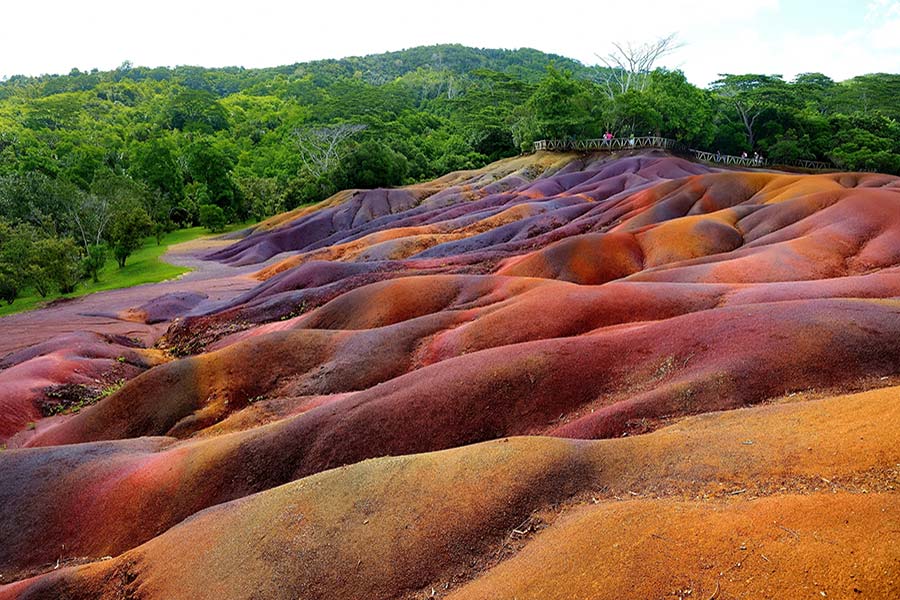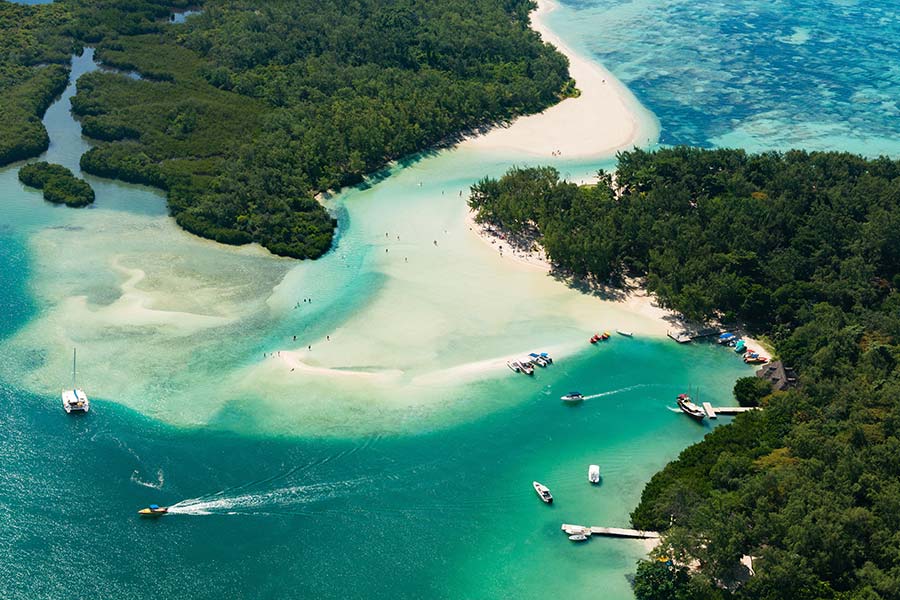Sommaire
It’s hard to say at what exact moment a journey begins. Some will choose the arrival in a heat-crushed airport, others the first cab or the first smile exchanged. However, the adventure often begins earlier, at home, with the plane ticket that you buy on a grey November evening, with the map that you unfold randomly on the coffee table. Take Mauritius for example. From the crumpled paper, the island emerges, a green dot surrounded by the ocean, a small window to Elsewhere. Its curves are revealed, its reliefs, its heights, its winding rivers. And the poetry of the names that already tell something. Grapefruit garden, Pointe aux piments, Piton de la Petite rivière noire … The journey, without warning, has just begun.
As the water flows
Mauritius is a small corner of the earth lost in the Indian Ocean, in the heart of the Mascarene archipelago. Less known than its neighbor Reunion Island, it nevertheless conceals a great natural wealth. The stretches of white sand, wedged between crystal clear waters and rows of coconut trees, have made its fame. The beach of La Cuvette (Mauritian poetry!), or that of Trou aux Biches, are among the most beautiful of the island. Bordered by filaos, they are the ideal refuge for a cure of rest, calm and sun.
Not far from the beaches, restaurants have sprung up here and there to showcase local gastronomic specialties. The opportunity, for example, to taste the briani. It is an emblematic dish of the island that combines rice, chicken, vegetables and spices. Stands of “street food” also offer all kinds of grilled fish, curry, rougail or samoussas … All faithfully accompanied by a chili paste called mazavarou. Mixed dishes that alone illustrate the mixing of populations on the island, coming in turn from Europe, Africa, India or China.
And scuba diving
Protected by the prevailing winds, the north and west coasts of the island are a call to marine exploration. Their turquoise waters invite you to float with the waves, armed with a mask and snorkel, to follow the ballet of multicolored fish. Sergeant-majors, sapphire damselfish, flying scorpion fish or butterfly fish populate the lagoons that the coral reef protects. Further out to sea, a careful eye may catch a glimpse of a few dolphins spouting from the blue waters of the Tamarin Bay.
Just about everywhere, diving clubs invite you to explore further to get up close and personal with sharks or slip between the walls of a wreck*. To reach the northern islands and their protected areas, some will opt for a catamaran excursion. This is undoubtedly the best way to approach the island of Coin de Mire, one of the wildest, classified as a nature reserve. There, the countless tropical fishes attract numerous birds which make the happiness of the ornithologists.
A geological rarity that deserves a look



For those who would like to visit the green forests of the South, go to the highest point of the island, the Piton de la Petite rivière noire at 828 meters.
Take a tour on the heights to discover the sacred lake of Grand Bassin, a great place of pilgrimage for Hindus. And then go back down to approach the Trou aux cerfs, a dormant volcanic crater where it is possible to venture out on foot. The Chamarel plain is now close by, with its impressive 100 meter high waterfall and the illustrious Terres des Sept couleurs, a geological rarity that is worth a look. Imagine dunes that change from ochre to mauve in the middle of the rainforest. And why not finish on the slopes of Piton-Canot with a 1.7km walk on a high path, and go and see up close endemic plants of the island such as the carrot wood or the camphor tree?
Mauritius: Bubbling land loaded with energy
But let there be no mistake! Mauritius is not just about splendid and silent sceneries that we would put in the background of our screen when we return from vacation. It is also a bubbling land, charged with the tremendous energy of its people. The Mauritian identity was forged inland and in the cheerful mess of cities such as Port Louis. At dusk, the streets of the capital come to life, the smells jostling each other. The workers of the day become beautiful at night to go and sway to sega rhythms. No need to master Creole to order a beer: French is by far the most widely spoken language, taught from an early age in public schools. During the day, you can also do some shopping on the lively market of Port-Louis where colorful fabrics, fruits and spices are mixed. There, let yourself be lulled by the echo of the voices that rise up, call out to each other, almost sing, and don’t resist the one who will offer you, with a smile, to bite into one of his chili cakes.
A strong story
A visit to Port-Louis is also a way to reconnect with the history of the island, punctuated by different waves of occupation. First the Portuguese, then the Dutch, the French and finally the British took possession of the island and its resources, establishing a system of great social inequality. Old colonial houses, some of which can be visited, are a reminder of these presences. On the road to Trou fanfaron, a high place of Mauritian memory stands. The Aapravasi Ghat building, classified as a World Heritage Site by Unesco, recalls the history of these 400,000 Indian workers who, from the abolition of slavery in 1835 until 1910, disembarked to join the sugar establishments of the island or Reunion.
Remnants of the colonial past
Other places tell an intense story of the dark slavery period, of the time when the Dutch and then the French chartered men and women from the African continent to work to the point of exhaustion in the sugar cane fields. This era, which scarred the memory of the inhabitants, has some symbols among which the Morne Brabant. This mountain in the south of the island, which became the refuge of runaway slaves, the source of many myths, is also classified as a UNESCO site. The view from the top is breathtaking.
A bath of culture
Another instructive stop is the Sugar Adventure Museum**. Housed in a beautiful sugar estate in Beau Plan, at the end of an alley of bougainvillea, l’Aventure du Sucre embraces the Ilian history of sugarcane. Discover its entire transformation process in an interactive tour that ends with a tasting of locally made unrefined sugars. If the coastal plains and the central plateau have allowed the extensive cultivation of sugar cane, tea is also part of the agricultural production of the island. Thus, go on the “tea road” to visit tea plantations and old colonial mansions like the Domaine des Aubineaux, converted into a museum. The Bois Chéri tea factory will finish off any remaining mysteries.
Grapefruit Garden
Finally, a detour to the Jardin du Pamplemousse is a must for plant lovers. In the northwest of the island, this 37-hectare botanical garden abounds with plant species from around the world. Clove trees, orchids, laurels… were collected at the end of the 18th century by Pierre Poivre, steward of Isle de France (as Mauritius was then called). His collections of plant species have been expanded over the generations. They have received visitors from all over the world including some illustrious people such as François Mitterrand and Nelson Mandela. What to walk in their footsteps and take with you, at the time of departure, the scents of this island with unsuspected charms.
Old colonial houses, some of which can be visited



** Practical information to visit the Sugar Adventure
The museum is open every day of the year from 9am to 5pm (except January 1 and 2 and December 24, 25, 26 and 31).
** Informations pratiques pour visiter l’Aventure du Sucre
Le musée est ouvert tous les jours de l’année de 9h à 17h (exceptés les 1 et 2 janvier et les 24, 25, 26 et 31 décembre).
Golf heaven is in Mauritius
Why do the best golfers in the world go to Mauritius? For the past twenty years, courses have been multiplying and reinventing themselves… To offer players spectacular terraines between mountains and lagoons. The island has many courses, which will offer seasoned players but also beginners a unique experience every time.
What are the best golf courses in Mauritius?
- Avalon Golf Estate: The newest golf course in Mauritius. It is nestled between Bois Chéri and Bois Sec. Far from the summer heat of the coastal regions, it borders tea plantations. Discover an 18-hole hilly course, to international standards. With 5 water courses and a prestigious Country Club. To stay there: Shanti Maurice Resort & Spa
- Mont Choisy Golf: This brand new golf course is the only 18-hole course in the north of the island. World-class players come to play here! Appreciating as much the view on the mountains and the historical heritage as the quality of the fairways. To Stay: The Trou aux Biches Beachcomber Golf Resort & Spa.
- Heritage Golf Club: Voted among the 10 best golf courses in Africa by CNN Travel… This is definitely one of the most beautiful Mauritian settings! On a still preserved coastline, with a beautiful lagoon and uncrowded beaches. The course offers breathtaking views of the sea. To stay: Heritage Le Telfair.
- L’Ile aux Cerfs Golf Club: This “Golf Island” has one of the 15 most beautiful courses in the world. With a view of the mythical lagoon of Ile aux Cerfs, vast white sand bunkers… But also a natural environment consisting of volcanic rocks, ponds and lush tropical vegetation. Whatever your level, this course will be for you an unforgettable experience. To stay: Anahita Golf & Spa Resort.
Practical Notebook Mauritius
When to go to Mauritius ?
Mauritius is a pleasant destination all year round. The period from September to April is the most involved for diving and June to September for surfing.
What is the climate like in Mauritius?
The Mauritian climate is tropical. It varies according to the time of the year and the place where you are. The hottest period is between November and March with temperatures between 28 and 35°. The coldest time of the Mauritian “winter” is from June to August. The average temperature drops to 22-24°. The rainy season is from November to March, the rains are tropical and short-lived. The water temperature
What is the capital of Mauritius?
Port Louis with 155 226 inhabitants.
What languages are spoken in Mauritius?
English is the administrative language. French is commonly spoken. Creole is the usual language. Some oriental languages are also spoken.
What is the time difference in Mauritius?
+3 hours compared to France in winter; +2 hours in summer.
How many hours flight to Mauritius?
About 11 hours from Paris by direct flight.
What is the procedure to enter Mauritius?
European Union citizens must hold a passport valid until the date of their return.
What are the religions in Mauritius?
Hinduism, Christianity, Islam and Buddhism.
What is the currency of Mauritius?
The unit of currency is the Mauritian rupee (Rs) divided into 100 cents. One euro: about 40 rupees.
Which vaccine to get to Mauritius ?
No vaccinations are required, except for yellow fever for travelers coming from an infected area (and only in this case).




